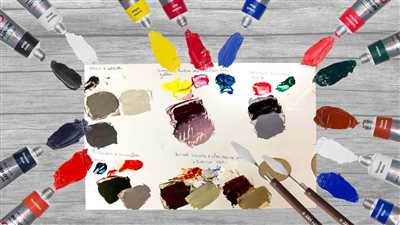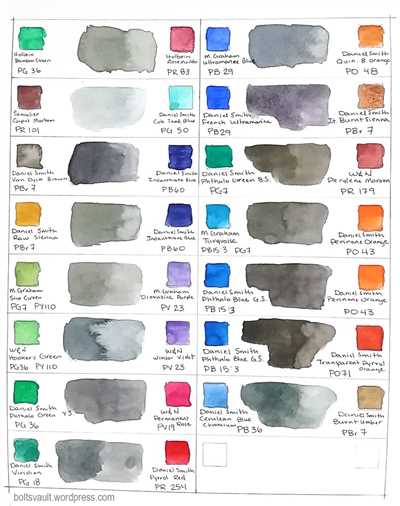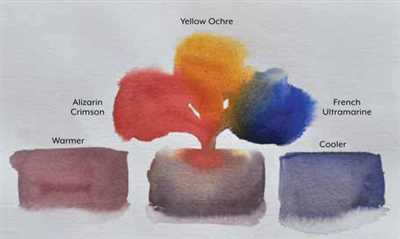
Grey is a versatile color that can add a calming and sophisticated touch to any space. Whether you’re painting your walls, furniture, or creating watercolor art, knowing how to make different shades of grey is essential. In this article, we will explore various methods and recipes for mixing greys, as well as important factors to consider when choosing the right grey paint for your project.
Grey paints are usually made by combining black and white, but there are many other colors that can be used to achieve different effects. While some shades of grey may appear cold and sterile, others can have a warm and inviting feel. For example, adding a small amount of green-based paint to your grey mixture can give it a more natural and calming look.
One of the easiest and most efficient ways to make grey paint is by using pre-mixed greys available in stores. These greys are carefully formulated to provide a balanced combination of black and white, resulting in a shade that is universally appealing. These ready-to-use greys are a safe choice if you are unsure about mixing your own shades or if you want to save time.
If you prefer a more personalized touch, you can create your own grey paint by mixing black and white to achieve the desired shade. Start with a small amount of black and gradually add white until you reach the desired tone. Remember to mix well so that the colors blend together effectively. You can also experiment with adding small amounts of other colors, such as blue or brown, to create unique shades of grey that suit your style.
When choosing the right grey paint, it’s important to consider factors such as the size of the space, the lighting conditions, and the overall style you want to achieve. Lighter shades of grey are great for small rooms as they can make the space look more open and airy. Darker greys, on the other hand, are perfect for creating a cozy and intimate atmosphere. Consider the other colors in your space, such as furniture and accents, and choose a grey that complements them well.
In summary, knowing how to make grey paint is an important skill for any painting project. Whether you choose to use pre-mixed greys or create your own, understanding how colors work together and how they can affect the overall look of a space is crucial. Take your time, ask questions, and don’t be afraid to experiment with different shades of grey to find the perfect combination for your project. With these tips and recipes, you’ll be well on your way to creating a stunning grey color palette!
- What Colors Make Gray – How to Make Gray Paint Yourself
- How To Use The Color Grey Effectively
- Recipes for Mixing Gray
- Choosing the Right Gray
- Methods for Mixing Gray
- Recipes for Mixing Gray
- Tips for Mixing Gray
- Can you whitewash with gray paint
- Frequently Asked Questions
- How Many Shades of Gray Are There
- What Two Colors Make Gray
- Video:
- how to make silver grey colour | dark grey colour | light grey colour mixing | acrylic colour mixing
What Colors Make Gray – How to Make Gray Paint Yourself
Gray is a versatile and popular color that can add a touch of sophistication to any space. Whether you are painting a small room or creating a calming workspace, knowing how to make gray paint yourself can help you achieve the perfect shade for your needs.
There are many different colors that can be mixed together to create gray. The most commonly used method involves mixing equal parts of black and white. This combination will give you a classic gray color that works well in any style of decor.
But if you want to get more creative with your gray paint, you can use other colors to create different shades and effects. For example, mixing blue and orange together with white can create a cool gray with a hint of warmth. Green-based grays can have a calming effect and work well in spaces where you want to create a serene atmosphere.
When choosing colors to mix, it’s important to consider the undertones of each color. Some colors may have subtle undertones that can affect the final shade of gray when mixed together.
Here are a few color combinations you can use to create different shades of gray:
- Black + White = Classic Gray
- Blue + Orange + White = Cool Gray
- Green + Blue + White = Calming Gray
- Purple + Green + White = Rich Gray
These are just a few examples, and you can experiment with different color combinations to find the gray that suits your style and needs.
There are even more ways to make gray paint. Some artists prefer to use watercolor techniques, while others choose to mix in a small amount of other colors to add accents or create shadow effects.
If you’re not sure where to start, there are plenty of resources available to help you. Online tutorials, books, and even art classes can provide guidance on how to effectively mix colors to create gray.
Creating your own gray paint can be a fun and efficient way to achieve the look you want. By mixing colors together, you can easily customize shades of gray to suit your specific needs and preferences.
So go ahead and explore the world of gray paint! You’ll be amazed at the variety of colors and shades you can create with a little mixing and experimenting. And if you have any questions along the way, don’t hesitate to ask for help – there are many experienced artists and professionals who can guide you in choosing the perfect colors for your gray paint.
How To Use The Color Grey Effectively

Grey is a versatile color that can be used to create a wide range of effects when painting. Whether you are using it as the main color or as an accent shade, grey can easily be combined with other colors to achieve the perfect look for your workspace or home.
When choosing grey paint, there are many different shades to choose from. Most commonly, people opt for neutral grey tones, which are the safest and most frequently used. However, you can also experiment with green-based greys or other vivid shades to create a more unique and vibrant effect.
One of the great things about grey is its calming effect. It is often used in therapy and wellness spaces for its ability to create a soothing and relaxing ambiance. Grey can also be used to create depth and shadow in paintings, making it an important color for artists to know how to use effectively.
If you’re unsure about how to use grey in your painting or home decor, here are a few frequently asked questions that may help:
| Question | Answer |
|---|---|
| What colors can be mixed to make grey paint? | To make grey paint, you can mix different shades of black and white. Experiment with adding small amounts of other colors to create different undertones. |
| How do you choose the right shade of grey? | When choosing a shade of grey, consider the overall style and look you want to achieve. Lighter greys tend to open up small spaces and make them look more efficient, while darker greys can create a cozy and warm feeling. |
| What are some popular color combinations with grey? | Grey pairs well with a variety of colors. Some popular combinations include grey and white, grey and blue, grey and yellow, and grey and pink. Experiment with different combinations to find what works best for you. |
| Are there any other uses for the color grey? | Aside from painting, grey can be used in interior design to create a modern and sophisticated look. It can also be used as a base color for whitewash or as an accent color to add depth to a room. |
So, whether you’re painting with watercolor or decorating your home, grey is a color that can be used effectively in a variety of ways. Take these tips and recipes into consideration to create the perfect grey look for your space.
Recipes for Mixing Gray
When it comes to painting, gray is one of the most commonly used colors in the world. It is a versatile shade that can easily be combined with other colors to create different effects. Gray paint is frequently used in home decor, as well as in art therapy and reflexology. Below, we’ll take a look at some of the most frequently asked questions about mixing gray paint, as well as some recipes for creating the perfect shade.
Choosing the Right Gray
There are many different shades of gray to choose from, so it’s important to know what you’re looking for. Some grays have a cool, blue-based undertone, while others have a warm, yellow-based undertone. When choosing a gray paint, consider the overall color scheme of the room or space where it will be used. A green-based gray, for example, can create a calming and peaceful atmosphere, while a vivid gray can add drama and depth to a space.
Methods for Mixing Gray
There are several methods for mixing gray paint. One of the easiest and most efficient ways is to start with two primary colors: black and white. Depending on the proportions you use, you can create a light gray or a dark gray. Another method is to mix complementary colors together, such as blue and orange, or red and green. This combination will result in a neutral gray.
Recipes for Mixing Gray
Here are a few recipes for mixing gray paint:
- Equal parts black and white
- 4 parts blue, 1 part orange
- 2 parts red, 1 part green
- 3 parts yellow, 1 part purple
These recipes can be adjusted to create lighter or darker grays, depending on your preference. It’s also worth noting that adding a small amount of another color, such as blue or purple, can create a unique undertone to the gray.
Tips for Mixing Gray

When mixing gray paint, it’s important to work in a well-lit and open workspace. This will allow you to see the true color of the paint as you mix it. Start with a small amount of each color and gradually add more until you achieve the desired shade. Remember, it’s easier to make gray lighter by adding more white, but once it’s too light, it’s difficult to darken it without starting over.
Gray paint is a versatile and calming color that can be used in a variety of ways. Whether you’re creating an accent wall or painting a watercolor masterpiece, these recipes for mixing gray will help you achieve the perfect shade. So go ahead and get creative with your grays!
Can you whitewash with gray paint
When it comes to painting, gray is a color that is frequently chosen by artists and DIY enthusiasts alike. It is a versatile shade that can be used effectively in many different styles and spaces. Gray paint can create a calming and soothing effect, making it perfect for creating a wellness-focused workspace or a small therapy area.
The world of gray paint is vast, with many shades and tones to choose from. Some people prefer warmer grays with green-based undertones, while others like cooler grays with blue or purple undertones. Whatever your style or preference, there is a gray out there that will suit your needs.
One of the most important things to keep in mind when choosing gray paint is that it can easily be mixed with other colors to create unique combinations and shades. Many artists and painters will even mix their own gray paint using watercolor or acrylic paints. This allows for more control over the final result and can help achieve specific effects, such as creating shadows or adding accents.
So, can you whitewash with gray paint? The answer is yes! Whitewashing with gray paint can give your surfaces a beautiful, weathered look. It is a great technique for adding depth and character to furniture, walls, and other objects. By diluting gray paint with water, you can achieve a translucent effect that allows the natural grain and texture of the surface to show through.
If you are looking to whitewash with gray paint, there are a few methods you can try. One of the most popular methods is to mix gray paint with water and apply it to the surface using a brush or sponge. Another method is to mix gray paint with white paint to create a lighter shade, which can be applied over the surface for a more subtle effect.
In conclusion, gray paint is a versatile and efficient choice for both painting and whitewashing. Its calming and soothing qualities make it perfect for creating a serene environment. Whether you choose to use pre-made gray paint or mix your own, the possibilities are endless. So go ahead and explore the world of grays in your next painting project!
Frequently Asked Questions
Q: How do I make grey paint?
A: There are different methods to make grey paint depending on the style and effect you want to achieve. One common method is to mix two or more colors together, usually black and white, to create different shades of grey. Another method is to use green-based colors, like olive or sage, and mix them with white to create calming and vivid greys.
Q: What are some good color combinations to use with grey paint?
A: Grey is a versatile color that can be paired with many other colors to create a perfect combination. Some popular choices are grey with accents of blue or yellow for a calming and cheerful look, or grey with shades of red or purple for a more dramatic effect. It all depends on your personal preferences and the atmosphere you want to create in your workspace or living space.
Q: Can I use grey paint in watercolor painting?
A: Absolutely! Grey paint can be used in watercolor painting to create shadows and add depth to your artwork. It is important to choose the right shades of grey to achieve the desired effect, whether it’s a cool grey for a serene landscape or a warm grey for a cozy interior scene. Experiment with different combinations and techniques to find what works best for you.
Q: How do I choose the right shade of grey for my painting?
A: Choosing the right shade of grey depends on the overall color palette and mood you want to convey in your painting. Consider the subject matter, lighting, and other elements in your artwork. Lighter greys tend to create a softer and more airy feel, while darker greys can add depth and drama. Take your time to experiment and trust your instincts when selecting the perfect grey for your piece.
Q: Are there any wellness or therapeutic benefits of painting with grey?
A: While painting with grey may not have specific wellness or therapeutic benefits like reflexology or other forms of therapy, it can still have a calming and soothing effect on your mind. Grey is often associated with neutrality and balance, which can help create a sense of harmony and tranquility in your creative workspace. Many artists over the years have found working with shades of grey to be a comforting and efficient way to express their artistic vision.
Q: How long does grey paint usually last?
A: The longevity of grey paint depends on various factors, such as the quality of the paint, the conditions it is exposed to, and how well it is maintained. Generally, high-quality paints and proper application can ensure that the paint lasts for many years without significant fading or discoloration. Taking good care of your painted surfaces, like avoiding harsh chemicals or excessive scrubbing, can also help prolong the life of the grey paint.
Q: Where can I find grey paint recipes?
A: There are many resources available online and in books that provide grey paint recipes. These recipes often include the different color combinations and proportions to achieve specific shades of grey. Some paint manufacturers also offer pre-mixed grey paints in various shades, making it easy for you to quickly find the perfect grey for your project without the need to mix your own.
Q: What is the safest and most efficient way to create grey paint?
A: The safest and most efficient way to create grey paint is to use pre-mixed grey paints from reputable manufacturers. This eliminates the need for mixing different colors together, reducing the risk of creating unwanted shades or wasting paint. However, if you prefer to mix your own grey paint, it is important to use high-quality pigments and follow reliable recipes to ensure consistent and desired results.
Q: Can grey paint be used for whitewash?
A: Yes, grey paint can be used for whitewashing purposes. Whitewashing is a technique that involves applying a diluted paint mixture to create a semi-transparent and rustic look. By diluting grey paint with water, you can achieve a softer and more subtle whitewash effect. Experiment with different water-to-paint ratios to find the perfect balance for your desired whitewashing style.
How Many Shades of Gray Are There
When it comes to painting, gray is one of the most frequently used colors. Its versatility allows it to be used in a variety of different ways, from creating a perfect backdrop for colorful accents to adding a calming effect to a space. But just how many shades of gray are there?
Well, the answer to that question is not as simple as it may seem. Gray is actually a combination of two different colors – black and white. And depending on the proportions of these two colors, you can create a wide range of shades of gray. For example, adding more black will result in a darker gray, while adding more white will create a lighter shade.
But it doesn’t stop there. Gray can also have undertones of other colors, such as green or blue. These undertones can give gray paint a unique and vivid look, making it even more versatile for different design styles and themes.
If you’re looking for the safest and most commonly used grays, you can start with the neutral gray palette. These grays are usually watercolor-like and have a subtle warmth to them. They work well as a base color and can be easily layered with other colors.
But if you’re feeling a bit more adventurous, you can try mixing your own shades of gray. There are plenty of recipes out there that can help you choose the perfect gray for your space. Just keep in mind that gray paint can look slightly different on the wall compared to the small sample you see in the store, so it’s always a good idea to test a small area before committing to a whole room.
When choosing a gray shade, it’s also important to consider the lighting in your space. Gray can be influenced by the natural light in the room, as well as the type of artificial lighting you use. To make sure you get the desired effect, it’s best to paint a large sample on the wall and observe it at different times of the day.
Gray paint is not only popular for its aesthetic appeal, but it also has some wellness benefits. Gray is often associated with relaxation and can be used effectively in spaces meant for therapy or meditation. Its calming effect can create a peaceful atmosphere and help promote a sense of well-being.
So, the next time you find yourself in the paint aisle, don’t be overwhelmed by the many shades of gray. Take your time and ask yourself what effect you want to achieve in your space. With a little bit of experimentation and research, you can find the perfect shade of gray that will work well with your style and make your space look great.
In the end, it’s all about finding the right balance between light and shadow, and gray can be the perfect color to achieve that. Whether you use it for painting walls, creating accents, or even mixing it with other colors, gray can open up a whole new world of possibilities in your workspace or home.
So, don’t be afraid to explore different shades of gray and see what works best for you. After all, gray is anything but boring!
What Two Colors Make Gray
Gray is a versatile and calming color that can add a touch of sophistication and elegance to any space. If you are looking to paint your walls gray, it is important to know what two colors can be combined to create this timeless hue.
Gray is created by mixing two primary colors together: black and white. Black and white are not technically colors, but rather shades. When they are combined, they create different tones of gray. The ratio of black and white will determine the shade of gray you achieve. Adding more or less black or white will result in darker or lighter grays, respectively.
The safest and most frequently used method of creating gray is to start with equal amounts of black and white. This will give you a neutral gray that can easily be adjusted to your liking. From there, you can experiment by adding small amounts of other colors to create different accents or undertones.
Another popular way to create gray is by using complementary colors. Complementary colors are opposites on the color wheel. In the case of gray, the complementary colors are blue and orange. Mixing blue and orange together will create a gray with a blue undertone.
It’s worth mentioning that green-based grays are often considered the most calming and spa-like. If you are looking to create a serene and relaxing atmosphere in your space, choosing a green-based gray might be a good option.
When it comes to painting, it is important to choose the right gray for your needs. If you are painting a large space, consider using a lighter gray to make the room feel more open and spacious. On the other hand, if you are painting a small room or want to create a cozy atmosphere, a darker gray can help achieve that effect.
Overall, creating the perfect gray for your space requires some experimentation and a bit of trial and error. Don’t be afraid to mix different shades of gray together to find what works best for you. Gray is a versatile color that can enhance any style or look great in any room, so get creative and have fun!









